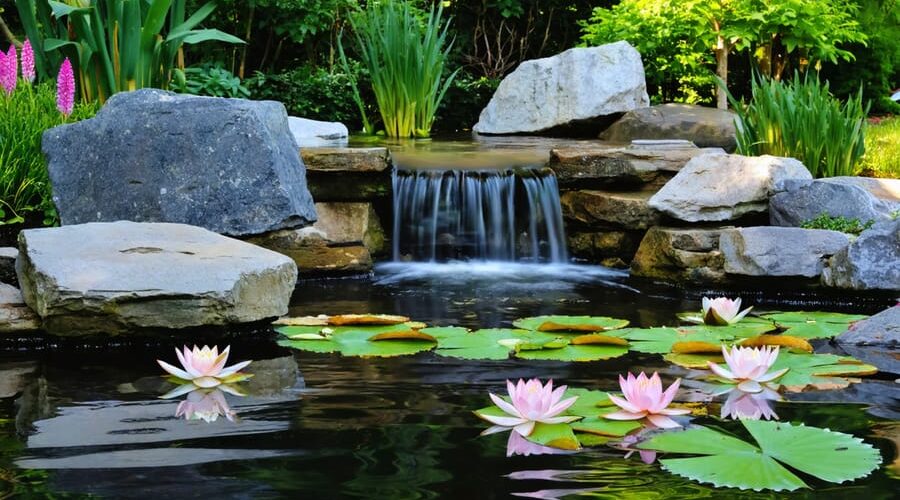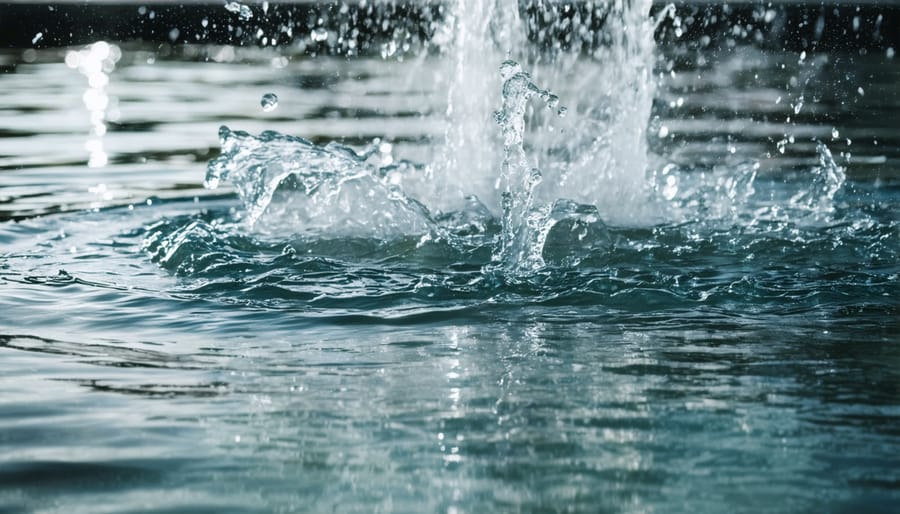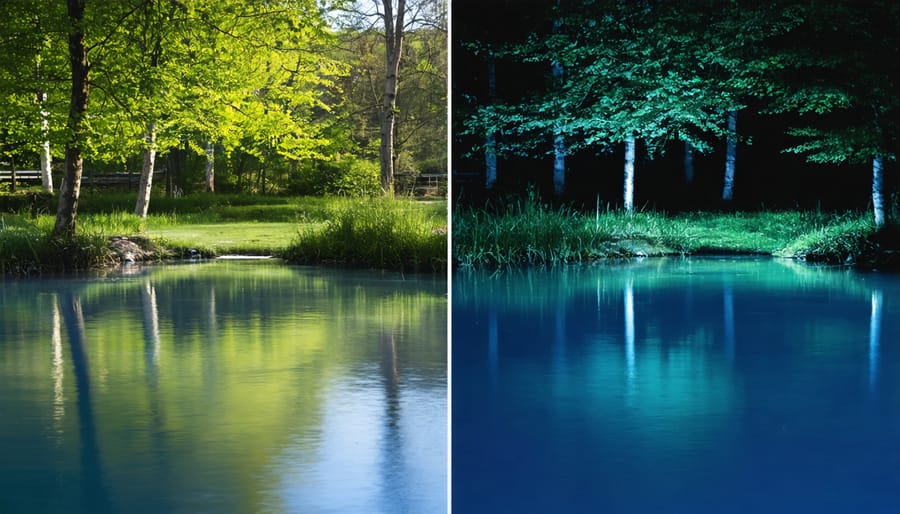
Transform Your Pond into Living Art: Mastering the Power of Contrast
Juxtaposition in artwork creates powerful visual tension by placing contrasting elements side by side, transforming ordinary compositions into compelling masterpieces. In natural pond design, this principle comes alive through thoughtful combinations of smooth river rocks against jagged boulders, delicate water lilies floating over dark depths, and structured architectural elements meeting wild, organic plantings. Artists and designers have long recognized that these intentional contrasts capture attention, guide the viewer’s eye, and create emotional resonance within a space. Whether working with color, texture, size, or form, juxtaposition serves as a fundamental tool for creating visual interest and depth in any artistic composition. By understanding and applying these contrasts deliberately, even beginning pond enthusiasts can create striking water features that tell compelling visual stories in their backyards.
Natural vs. Architectural Elements
Hard vs. Soft Landscaping
One of the most striking ways to create visual interest in your pond design is through the thoughtful combination of local stone features and soft, flowing plants. This classic contrast mirrors what we see in nature, where rigid rock formations meet cascading vegetation. Think of how a waterfall’s solid granite face becomes softened by delicate ferns and moss growing along its edges.
To achieve this balance in your pond, start by establishing your hardscape elements – boulders, stone walls, or decorative rocks. These provide the strong architectural foundation that will anchor your design. Then, introduce softer elements like trailing plants, marginals, and floating vegetation that will grow and move with the breeze.
Consider placing upright plants like iris or cattails against a textured rock wall, or letting creeping jenny cascade over stone edges. Water lilies floating on the surface create an especially beautiful contrast when positioned near angular stone features. The key is to let the rigid lines of your hardscaping peek through while allowing the natural movement of plants to soften the overall appearance.
Remember that this juxtaposition isn’t just about looks – it’s also practical. The stones provide structure and stability, while plants help filter the water and create natural habitats for pond life. This combination creates a dynamic, living artwork that changes with the seasons.
Geometric vs. Free-Form Shapes
One of the most powerful ways to create visual interest in your artwork is by combining geometric and organic shapes. Think of how a perfectly circular moon looks against the irregular silhouette of a mountain – that’s the magic of geometric versus free-form juxtaposition! In your designs, try pairing straight lines and perfect circles with flowing, natural curves to create dynamic tension.
Start by identifying opportunities to blend these contrasting elements. For example, you might frame a wildflower garden bed with crisp rectangular borders, or edge a naturally-shaped pond with geometric stepping stones. The key is finding the right balance – too many rigid shapes can feel harsh, while too many organic forms might lack structure.
Here are some practical ways to blend both:
– Use circular planters to display climbing vines
– Create a straight pathway that winds through naturalistic plantings
– Install angular garden art among rounded shrubs
– Combine sharp-edged rocks with flowing water features
When working with these contrasts, consider the overall composition. Sometimes a single geometric element can anchor an otherwise free-flowing design. Think of it like a conductor’s baton bringing order to an orchestra – it guides the eye while letting natural beauty flourish around it.
Remember that nature itself often combines both elements. Look at how tree branches create organic patterns within their overall triangular shape for inspiration. The goal isn’t perfection but rather finding that sweet spot where structure meets spontaneity.

Color and Texture Contrasts
Water Surface Effects
Water surfaces offer a fascinating canvas for creating dramatic juxtaposition in your pond design. By combining still and moving water features, you can craft a dynamic visual experience that captivates viewers and adds depth to your water garden. The contrast between peaceful, mirror-like surfaces and energetic, rippling water creates an engaging interplay of textures and reflections.
To achieve this effect, consider placing a smooth, flat pond surface next to a cascading waterfall or bubbling fountain. The still water acts as a natural mirror, reflecting the sky and surrounding landscape, while the moving water introduces energy and sound. This contrast not only pleases the eye but also soothes the mind with its harmonious balance.
Try incorporating different water levels in your design. A raised pond section flowing into a lower pool creates natural movement while maintaining areas of tranquility. Small stepping stones or partially submerged rocks can create gentle ripples that contrast beautifully with undisturbed areas.
For added impact, experiment with lighting. Evening illumination can emphasize the difference between still and moving water, as light plays differently on each surface. Underwater lights beneath still areas create ethereal glows, while spotlights on moving water highlight the dynamic patterns of splashing droplets.
Remember that seasonal changes affect water movement too. In winter, still surfaces might freeze while moving water remains fluid, creating natural contrasts that evolve throughout the year.

Plant and Material Selection
When creating visual impact in your pond artwork, the careful selection of plants and materials plays a crucial role in achieving striking juxtaposition. Start by considering contrasting colors – pair deep purple water lilies with bright yellow marsh marigolds, or combine the rich green of rushes with the silvery-blue of ornamental grasses. These color combinations create immediate visual interest and draw the eye naturally across your water feature.
Texture is equally important in creating compelling contrasts. Consider integrating native materials like smooth river rocks alongside rough-textured bog plants. The interplay between soft, flowing water plants and rigid structural elements like stone or driftwood creates a dynamic visual tension that makes your pond more engaging.
When selecting materials, think about combining different finishes – glossy leaves against matte stones, or transparent water against opaque decorative elements. Mix vertical plants like iris or cattails with spreading ground covers to create depth and dimension. Remember to consider seasonal changes too – choose plants that will provide contrasting colors and textures throughout the year, ensuring your pond remains visually interesting even as plants cycle through their natural growth patterns.
For maximum impact, limit your palette to three or four main contrasting elements. This prevents the design from becoming chaotic while still maintaining the dramatic effect of juxtaposition.
Light and Shadow Play
Day vs. Night Effects
One of the most captivating aspects of pond artwork is how it transforms from day to night, creating two distinct visual experiences. During daylight hours, your artwork catches natural sunlight, highlighting textures, colors, and reflective surfaces. The sun’s position throughout the day creates ever-changing shadows that dance across your water features, making them appear different as hours pass.
Natural lighting reveals the intricate details of your artwork – from the subtle variations in stone textures to the gleaming surfaces of metal sculptures. Bright sunlight brings out vibrant colors in mosaic pieces and painted elements, while also creating sparkles and shimmer on the water’s surface that interact with your artistic elements.
As dusk approaches, strategic lighting can completely transform your pond artwork into a magical nighttime display. Underwater lights cast mysterious glows that illuminate sculptures from below, creating dramatic silhouettes and shadows. Spotlights positioned at different angles can emphasize specific features that might go unnoticed during the day.
Consider installing color-changing LED lights to add another dimension to your nighttime display. These can create different moods throughout the evening or highlight specific seasons and celebrations. Floating lights or illuminated floating artwork pieces take on an ethereal quality after dark, seeming to hover mysteriously above the water’s surface.
The contrast between day and night appearances adds depth to your artistic expression. Features that command attention during daylight hours might become subtle background elements at night, while previously understated pieces can transform into stunning focal points under artificial lighting. This day-to-night transformation essentially gives you two different artistic displays in one space, doubling the visual interest of your pond area.
Remember to view your pond artwork at different times of day while planning your design. This helps ensure your creation remains visually engaging around the clock, offering unique experiences whether viewed in bright sunshine or under the stars.

Seasonal Juxtaposition
Creating year-round visual interest in your pond requires careful consideration of seasonal changes and their potential for striking contrasts. By planning your pond design with all four seasons in mind, you can ensure your water feature remains captivating throughout the year while achieving perfect natural landscape integration.
Consider pairing deciduous trees with evergreen plants around your pond’s edge. During autumn, the vibrant reds and golds of falling leaves create a dramatic contrast against the deep greens of surrounding conifers. In winter, bare branches cast intricate shadows across the water’s surface, while evergreens maintain structure and color.
Spring offers excellent opportunities for seasonal juxtaposition through early-blooming water plants like iris and marsh marigold against the still-dormant backdrop. As summer arrives, combine tall, architectural plants like cattails with low-growing water lilies to create vertical contrast.
Water itself provides endless possibilities for seasonal contrast. In summer, rippling water reflects blue skies and green foliage, while winter brings mirror-like still surfaces that perfectly capture bare branches and moody skies. Consider incorporating elements like rocks or driftwood that take on different characters throughout the year – moss-covered in spring, sun-bleached in summer, frost-dusted in winter.
To maximize year-round interest, include:
– Plants with varying bloom times
– Foliage with different textures and colors
– Structural elements that weather beautifully
– Wildlife-friendly features that attract different creatures each season
Remember that successful seasonal juxtaposition isn’t just about planning for each season individually – it’s about understanding how these elements interact and transform throughout the year, creating an ever-changing but always engaging landscape.
As we’ve explored throughout this article, juxtaposition in pond design is a powerful tool that can transform your water feature from ordinary to extraordinary. By thoughtfully combining contrasting elements – whether it’s smooth river rocks against jagged boulders, vibrant water lilies beside serene grass plantings, or modern sculptures complementing natural elements – you create visual interest that draws the eye and engages the mind.
Remember that successful contrast doesn’t happen by accident. Take time to plan your design, considering how different textures, colors, shapes, and materials will interact. Start small by experimenting with simple contrasts, like placing dark and light plants next to each other, or mixing rounded and angular hardscape materials. As your confidence grows, try more ambitious combinations that tell your unique story.
Don’t be afraid to break traditional rules and trust your artistic instincts. Sometimes the most striking designs come from unexpected pairings. Whether you’re creating a formal water garden or a naturalistic pond, juxtaposition can help you achieve that perfect balance between harmony and excitement.
The beauty of using contrast in pond design is that it’s an ongoing creative process. As your plants grow and seasons change, new opportunities for artistic expression will emerge. Keep observing, adjusting, and experimenting with different combinations. Your pond is your canvas – let contrasting elements work together to create your own masterpiece of water gardening art.
